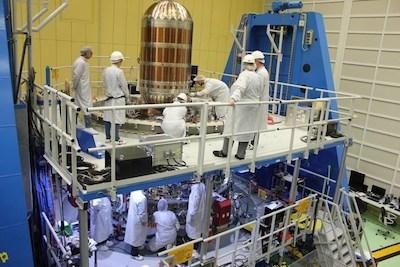Sun, Apr 29, 2018
European Service Module Being Assembled By Airbus In Bremen, Germany
The European service module that will provide power, water, air and electricity to NASA’s Orion Moon module has taken a large step closer to completion with the installation of its fuel tanks and testing of its solar wings.

The four tanks will each contain about 528 gallons of propellant. In the vacuum of space there is no air to burn so spacecraft fuel tanks include oxidiser and fuel that are mixed to ignite and provide thrust. The two sets of tanks are connected by intricate pipelines to 33 engines. Sensors and computers control the system.
The European service module is a small but complex spacecraft packed with equipment. The large tanks are installed as one of the last components to allow technicians more room to work. "Tank installation is a great achievement and a big step towards the start of the final acceptance tests in Europe," said ESA’s propulsion lead for Orion, Thierry Kachler.
Meanwhile, the solar arrays Orion will use to produce electricity are being tested at ESA’s technical heart in the Netherlands. Folded for launch, the fragile solar panels need to survive the rumbling into space aboard the most powerful rocket ever built, NASA’s Space Launch System.
Orion’s solar panels will be folded inside the rocket fairing on the first leg of the trip around the Moon. Once released from the rocket they will unfold and rotate towards the Sun to start delivering power. To make sure the solar panels will work after the intense launch, ESA engineers are putting them through rigorous tests that exceed what they will experience on launch day. This includes vibrating them on a shaking table and placing them in front of enormous speakers that recreate the harsh launch conditions. Once they pass these tests they can be sent to Bremen to join the service module.
The service module is set to ship to the U.S. this summer for further tests and integration with the crew module adaptor.
The large tanks that will provide propellant for the spacecraft are now fitting snuggly inside the spacecraft at the Airbus assembly hall in Bremen, Germany.
Orion will eventually fly beyond the Moon with astronauts. The first mission – without astronauts – is getting ready for launch in 2019.
(Image provided with ESA news release)
More News
The Industry Continues to be Rocked By Some Questionable Operations Recent investigations and a great deal of data has resulted in ANN’s SportPlane Resource Guide’s rep>[...]
Make Sure You NEVER Miss A New Story From Aero-News Network Do you ever feel like you never see posts from a certain person or page on Facebook or Instagram? Here’s how you c>[...]
Visual Approach Slope Indicator (VASI) An airport lighting facility providing vertical visual approach slope guidance to aircraft during approach to landing by radiating a directio>[...]
Airport Marking Aids Markings used on runway and taxiway surfaces to identify a specific runway, a runway threshold, a centerline, a hold line, etc. A runway should be marked in ac>[...]
Aero Linx: The Skyhawk Association The Skyhawk Association is a non-profit organization founded by former Skyhawk Pilots which is open to anyone with an affinity for the A-4 Skyhaw>[...]
 Unfortunate... ANN/SportPlane Resource Guide Adds To Cautionary Advisories
Unfortunate... ANN/SportPlane Resource Guide Adds To Cautionary Advisories ANN FAQ: Turn On Post Notifications
ANN FAQ: Turn On Post Notifications ANN's Daily Aero-Term (04.29.24): Visual Approach Slope Indicator (VASI)
ANN's Daily Aero-Term (04.29.24): Visual Approach Slope Indicator (VASI) ANN's Daily Aero-Term (04.28.24): Airport Marking Aids
ANN's Daily Aero-Term (04.28.24): Airport Marking Aids ANN's Daily Aero-Linx (04.28.24)
ANN's Daily Aero-Linx (04.28.24)



